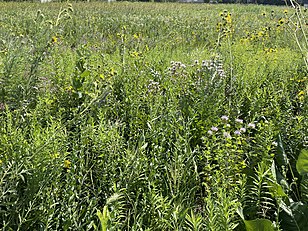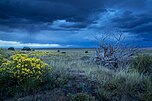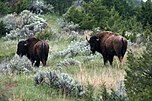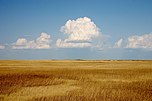Prairies are ecosystems considered part of the temperate grasslands, savannas, and shrublands biome by ecologists, based on similar temperate climates, moderate rainfall, and a composition of grasses, herbs, and shrubs, rather than trees, as the dominant vegetation type. Temperate grassland regions include the Pampas of Argentina, Brazil and Uruguay, and the steppe of Ukraine, Russia, and Kazakhstan. Lands typically referred to as "prairie" tend to be in North America. The term encompasses the lower and mid-latitude of the area referred to as the Interior Plains of Canada, the United States, and Mexico. It includes all of the Great Plains as well as the wetter, hillier land to the east. From west to east, generally the drier expanse of shortgrass prairie gives way to mixed grass prairie and ultimately the richer soils of the tallgrass prairie.
In the U.S., the area is constituted by most or all of the states, from north to south, of North Dakota, South Dakota, Nebraska, Kansas, and Oklahoma, and sizable parts of the states of Montana, Wyoming, Colorado, New Mexico, Texas in the west, and to the east, Minnesota, Wisconsin, Iowa, Missouri, Illinois, and Indiana. The Palouse of Washington and the Central Valley of California are also prairies. The Canadian Prairies occupy vast areas of Manitoba, Saskatchewan, and Alberta. Prairies may contain various lush flora and fauna, often contain rich soil maintained by biodiversity, with a temperate climate and a varied view.[1][2][3]
- ^ Alford, Aaron L.; Hellgren, Eric C.; Limb, Ryan; Engle, David M. (May 19, 2012). "Experimental tree removal in tallgrass prairie: variable responses of flora and fauna along a woody cover gradient". Ecological Applications. 22 (3): 947–958. doi:10.1890/10-1288.1. hdl:11244/321243. PMID 22645823 – via Wiley Online Library.
- ^ Agnew, William; Uresk, Daniel W.; Hansen, Richard M. (March 1986). "Flora and fauna associated with prairie dog colonies and adjacent ungrazed mixed-grass prairie in western South Dakota" (PDF). Journal of Range Management. 39 (2): 135–139. doi:10.2307/3899285. hdl:10150/645493. JSTOR 3899285 – via United States Department of Agriculture.
- ^ Lark, Tyler J. (2020-09-01). "Protecting our prairies: Research and policy actions for conserving America's grasslands". Land Use Policy. 97: 104727. doi:10.1016/j.landusepol.2020.104727. ISSN 0264-8377.








